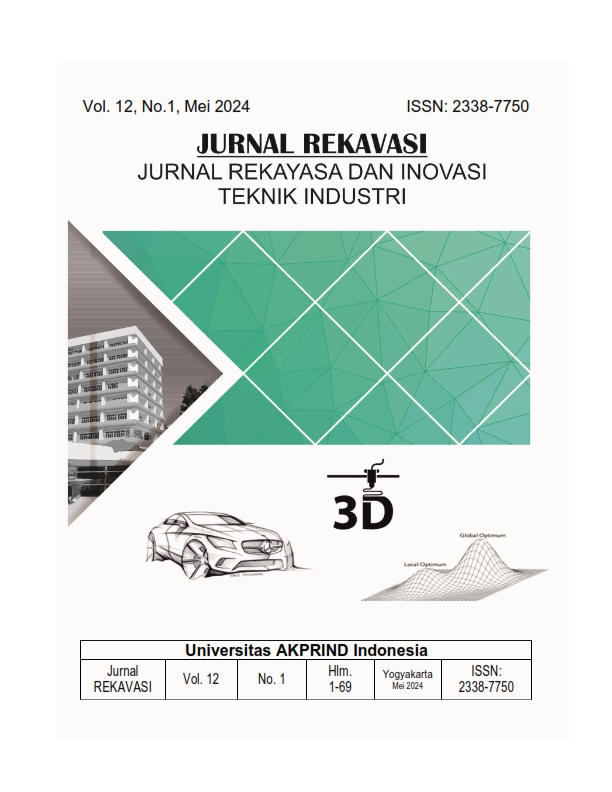PENGGUNAAN ANALISIS SENTIMEN UNTUK PERANCANGAN PRODUK: SEBUAH TINJAUAN PUSTAKA
DOI:
https://doi.org/10.34151/rekavasi.v12i1.4660Keywords:
perancangan produk, analisis sentimen, keinginan konsumen, tinjauan pustakaAbstract
Saat ini konsumen sering memberikan komentar dan review terhadap produk yang digunakannya melalui platform media sosial dan platform e-commerce. Perusahaan mempunyai peluang untuk memanfaatkan komentar dan review tersebut untuk mengetahui keinginan dan kebutuhan konsumen atas produk yang dihasilkannya. Keinginan dan kebutuhan konsumen tersebut merupakan masukan berarti dalam proses perancangan produk. Salah satu teknik yang akhir-akhir ini banyak dipakai untuk menilai komentar dan review konsumen adalah analisis sentimen. Artikel ini disusun dengan tujuan untuk mencermati sejauh mana analisis sentimen digunakan untuk mendukung proses perancangan produk melalui tinjauan pustaka dari penelitian dalam bidang ini. Pustaka dicari dengan menggunakan basis data Web of Science Core Collection dengan menggunakan kata kunci “product design” dan “sentiment analysis”. Setelah dilakukan pengkajian diperoleh lima puluh artikel yang relevan dengan kedua kata kunci tersebut. Dari artikel terpilih tersebut, dapat disimpulkan bahwa analisis sentimen memang telah banyak digunakan dalam mendukung proses perancangan produk, baik untuk produk baru maupun untuk proses perbaikan desain berbagai jenis produk termasuk jasa. Dalam penerapannya, analisis sentimen diintegrasikan dengan berbagai teknik perancangan produk seperti quality function deployment (QFD), metode Kano, dan metode Kansei. Terdapat dua kategori teknik untuk menentukan sentimen negatif atau positif yaitu teknik berdasarkan lexicon dan teknik machine learning. Analisis sentimen dalam proses perancangan produk juga diintegrasikan dengan konsep ontology dan fuzzy. Arah penelitian di masa datang adalah memperluas aplikasi ke jenis produk lain dan pengembangan teknik dengan integrasi berbagai teknik perancangan produk dan berbagai konsep dan teknik terkini dengan tujuan mendapatkan teknik yang sesuai dan akurat dalam mendapatkan keinginan konsumen.
References
Ali, M. M., Doumbouya, M. B., Louge, T., Rai, R., & Karray, M. H. (2020). Ontology-based approach to extract product's design features from online customers’ reviews. Computers in Industry, 116, 103175.
Ali, S., Wang, G., & Riaz, S. (2020). Aspect based sentiment analysis of ridesharing platform reviews for kansei engineering. IEEE Access, 8, 173186-173196.
Alotaibi, F. M. (2023). A machine-learning-inspired opinion extraction mechanism for classifying customer reviews on social media. Applied Sciences, 13(12), 7266.
Awad, N. A., & Mahmoud, A. (2021). Analyzing customer reviews on social media via applying association rule. Computers, Materials and Continua, 68(2), 1519-1530.
Chang, D., & Lee, C. (2018). A product affective properties identification approach based on web mining in a crowdsourcing environment. Journal of Engineering Design, 29(8-9), 449-483.
Chen, K., Jin, J., Zhao, Z., & Ji, P. (2022). Understanding customer regional differences from online opinions: a hierarchical Bayesian approach. Electronic Commerce Research, 1-27.
Chen, K., Luo, P., & Wang, H. (2017). An influence framework on product word-of-mouth (WoM) measurement. Information & Management, 54(2), 228-240.
Ghorbanloo, S., & Shokouhyar, S. (2023). Consumers' attitude footprint on sustainable development in developed and developing countries: a case study in the electronic industry. Operations Management Research, 16(3), 1444-1475.
Han, Y., & Moghaddam, M. (2021). Eliciting attribute-level user needs from online reviews with deep language models and information extraction. Journal of Mechanical Design, 143(6), 061403.
Hernández-Fernández, A., Mora, E., & Hernández, M. I. V. (2019). When a new technological product launching fails: A multi-method approach of facial recognition and E-WOM sentiment analysis. Physiology & behavior, 200, 130-138.
Hussain, J., Azhar, Z., Ahmad, H. F., Afzal, M., Raza, M., & Lee, S. (2022). User experience quantification model from online user reviews. Applied Sciences, 12(13), 6700.
Ireland, R., & Liu, A. (2018). Application of data analytics for product design: Sentiment analysis of online product reviews. CIRP Journal of Manufacturing Science and Technology, 23, 128-144.
Jiang, H., Kwong, C. K., Kremer, G. O., & Park, W. Y. (2019). Dynamic modelling of customer preferences for product design using DENFIS and opinion mining. Advanced Engineering Informatics, 42, 100969.
Jiang, H., Kwong, C. K., Park, W. Y., & Yu, K. M. (2018). A multi-objective PSO approach of mining association rules for affective design based on online customer reviews. Journal of Engineering Design, 29(7), 381-403.
Jiang, H., Sabetzadeh, F., Lin, Z., & Tang, H. (2022). Nonlinear time series fuzzy regression for developing explainable consumer preferences’ models based on online comments. IEEE Transactions on Fuzzy Systems, 30(10), 4460-4470.
Jiang, H., Wu, X., Sabetzadeh, F., & Chan, K. Y. (2023). Developing explicit customer preference models using fuzzy regression with nonlinear structure. Complex & Intelligent Systems, 9(5), 4899-4909.
Jiao, Y., & Qu, Q. X. (2019). A proposal for Kansei knowledge extraction method based on natural language processing technology and online product reviews. Computers in Industry, 108, 1-11.
Jin, J., Ji, P., & Gu, R. (2016). Identifying comparative customer requirements from product online reviews for competitor analysis. Engineering Applications of Artificial Intelligence, 49, 61-73.
Jin, J., Ji, P., & Kwong, C. K. (2016). What makes consumers unsatisfied with your products: Review analysis at a fine-grained level. Engineering Applications of Artificial Intelligence, 47, 38-48.
Jin, J., Liu, Y., Ji, P., & Kwong, C. K. (2019). Review on recent advances in information mining from big consumer opinion data for product design. Journal of Computing and Information Science in Engineering, 19(1), 010801.
Jin, J., Liu, Y., Ji, P., & Liu, H. (2016). Understanding big consumer opinion data for market-driven product design. International Journal of Production Research, 54(10), 3019-3041.
Joung, J., & Kim, H. M. (2021). Approach for importance–performance analysis of product attributes from online reviews. Journal of Mechanical Design, 143(8), 081705.
Joung, J., & Kim, H. M. (2022). Explainable neural network-based approach to Kano categorisation of product features from online reviews. International Journal of Production Research, 60(23), 7053-7073.
Kreuzbauer, R., & Malter, A. J. (2005). Embodied cognition and new product design: Changing product form to influence brand categorization. Journal of Product Innovation Management, 22(2), 165-176.
Lau, R. Y., Li, C., & Liao, S. S. (2014). Social analytics: Learning fuzzy product ontologies for aspect-oriented sentiment analysis. Decision Support Systems, 65, 80-94.
Lee, J., Jeong, B., Yoon, J., & Song, C. H. (2023). Context-aware customer needs Identification by linguistic pattern mining based on online product reviews. IEEE Access, 11, 71859-71872.
Li, Y., Dong, Y., Wang, Y., & Zhang, N. (2023). Product design opportunity identification through mining the critical minority of customer online reviews. Electronic Commerce Research, 1-29.
Liu, C., & Xu, Y. (2021). Consumer sentiment involvement in big data analytics and its impact on product design innovation. Sustainability, 13(21), 11821.
Liu, P., Zhang, K., Dong, X., & Wang, P. (2024). A big data-Kano and SNA-CRP based QFD model: Application to product design under Chinese new E-commerce model. IEEE Transactions on Engineering Management, 71, 4246-4260.
Maarif, M. R., Syafrudin, M., & Fitriyani, N. L. (2024). Uncovering Sustainability Insights from Amazon’s Eco-Friendly Product Reviews for Design Optimization. Sustainability, 16(1), 172.
Mäntylä, M. V., Graziotin, D., & Kuutila, M. (2018). The evolution of sentiment analysis—A review of research topics, venues, and top cited papers. Computer Science Review, 27, 16-32.
Nazari-Shirkouhi, S., & Keramati, A. (2017). Modeling customer satisfaction with new product design using a flexible fuzzy regression-data envelopment analysis algorithm. Applied Mathematical Modelling, 50, 755-771.
Ng, C. Y., & Law, K. M. (2020). Investigating consumer preferences on product designs by analyzing opinions from social networks using evidential reasoning. Computers & Industrial Engineering, 139, 106180.
Park, J. (2020). Framework for sentiment-driven evaluation of customer satisfaction with cosmetics brands. IEEE Access, 8, 98526-98538.
Park, K., Park, S., & Joung, J. (2024). Contextual Meaning-based Approach to Fine-grained Online Product Review Analysis for Product Design. IEEE Access, 12, 4225-4238.
Quan, H., Li, S., Zeng, C., Wei, H., & Hu, J. (2023). Big data and AI-driven product design: a survey. Applied Sciences, 13(16), 9433.
Rathore, A. K., & Ilavarasan, P. V. (2020). Pre-and post-launch emotions in new product development: Insights from twitter analytics of three products. International Journal of Information Management, 50, 111-127.
Setchi, R., & Asikhia, O. K. (2017). Exploring user experience with image schemas, sentiments, and semantics. IEEE Transactions on Affective Computing, 10(2), 182-195.
Shepherd, J. (2024). 23 Essential Twitter (X) Statistics You Need to Know in 2024. The Social Shepherd. https://thesocialshepherd.com/blog/twitter-statistics
Sun, B., Mao, H., & Yin, C. (2022). How to identify product defects and segment consumer groups on an online auto forum. International Journal of Consumer Studies, 46(6), 2270-2287.
Sun, Q., Niu, J., Yao, Z., & Yan, H. (2019). Exploring eWOM in online customer reviews: Sentiment analysis at a fine-grained level. Engineering Applications of Artificial Intelligence, 81, 68-78.
Suryadi, D., & Kim, H. M. (2019). A data-driven approach to product usage context identification from online customer reviews. Journal of Mechanical Design, 141(12), 121104.
Wang, R., Liu, J., Li, M., Fu, C., & Hou, Y. (2024). Multi-modal online review driven product improvement design based on scientific effects knowledge graph. Journal of Engineering Design, 1-38.
Wang, W. M., Li, Z., Liu, L., Tian, Z. G., & Tsui, E. (2018). Mining of affective responses and affective intentions of products from unstructured text. Journal of Engineering Design, 29(7), 404-429.
Wang, W. M., Li, Z., Tian, Z. G., Wang, J. W., & Cheng, M. N. (2018). Extracting and summarizing affective features and responses from online product descriptions and reviews: A Kansei text mining approach. Engineering Applications of Artificial Intelligence, 73, 149-162.
Wang, W. M., Wang, J. W., Li, Z., Tian, Z. G., & Tsui, E. (2019). Multiple affective attribute classification of online customer product reviews: A heuristic deep learning method for supporting Kansei engineering. Engineering Applications of Artificial Intelligence, 85, 33-45.
Wang, X., He, J., Curry, D. J., & Ryoo, J. H. (2022). Attribute embedding: Learning hierarchical representations of product attributes from consumer reviews. Journal of Marketing, 86(6), 155-175.
Wang, Y., Lu, X., & Tan, Y. (2018). Impact of product attributes on customer satisfaction: An analysis of online reviews for washing machines. Electronic Commerce Research and Applications, 29, 1-11.
Wang, Z., Hu, S. J., & Liu, W. D. (2024). Product feature sentiment analysis based on GRU-CAP considering Chinese sarcasm recognition. Expert Systems with Applications, 241, 122512.
Xing, T., Wang, G., Yuan, L., Liu, Y., Ye, X., & Zhao, J. (2020). A systematic estimation approach for the importance of engineering characteristics based on online reviews. Proceedings of the Institution of Mechanical Engineers, Part B: Journal of Engineering Manufacture, 234(11), 1433-1447.
Yang, C., Wu, L., Tan, K., Yu, C., Zhou, Y., Tao, Y., & Song, Y. (2021). Online user review analysis for product evaluation and improvement. Journal of Theoretical and Applied Electronic Commerce Research, 16(5), 1598-1611.
Zhang, J., Zhang, A., Liu, D., & Bian, Y. (2021). Customer preferences extraction for air purifiers based on fine-grained sentiment analysis of online reviews. Knowledge-Based Systems, 228, 107259.
Zhang, L., Chu, X., & Xue, D. (2019). Identification of the to-be-improved product features based on online reviews for product redesign. International Journal of Production Research, 57(8), 2464-2479.
Zhang, M., Sun, L., Wang, G. A., Li, Y., & He, S. (2022). Using neutral sentiment reviews to improve customer requirement identification and product design strategies. International Journal of Production Economics, 254, 108641.
Zhang, N., Qin, L., Yu, P., Gao, W., & Li, Y. (2023). Grey-Markov model of user demands prediction based on online reviews. Journal of Engineering Design, 34(7), 487-521.
Zhou, F., Ayoub, J., Xu, Q., & Jessie Yang, X. (2020). A machine learning approach to customer needs analysis for product ecosystems. Journal of mechanical design, 142(1), 011101.










